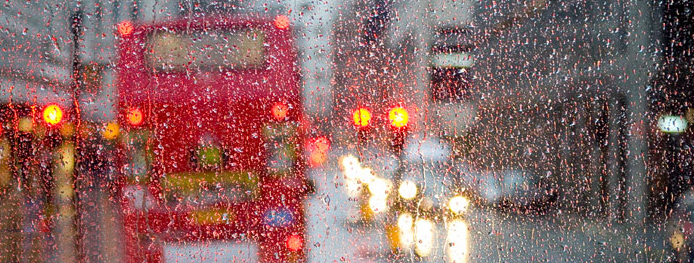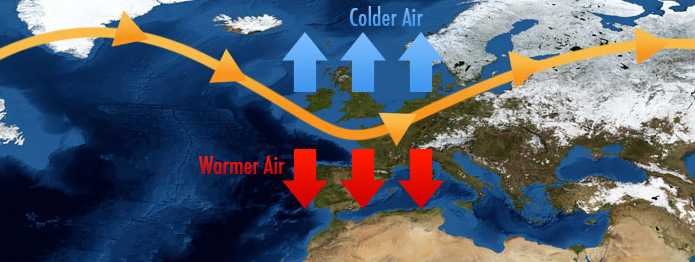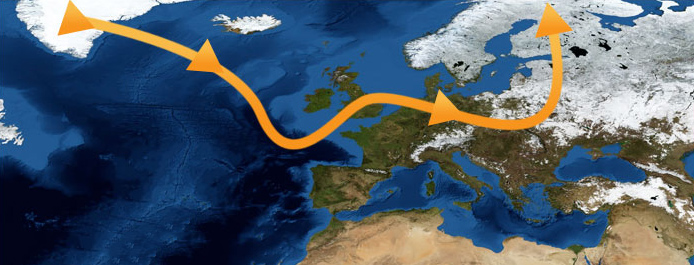Stuck in a Rut
The 2012 UK weather has become one of the most unusual and unpleasant on record.
The key feature of UK weather has always been changeability. We are used to sunshine one day and rain the next. Three days in a row with the same weather has usually been worth a mention in conversations, but when a complete month goes by with little change in the weather, something special (and mostly unpleasant up to mid July this year) must be happening.

The 2012 UK weather
A period of the bitterly cold weather sweeping Britain in February was followed by dull but dry weather in March. This sparked off concerns of a drought in the summer to come! That was followed by the wettest April and the wettest June on record. In between was a long period of exceptionally warm weather in the second half of May.
Long-duration extreme events, killer sub-zero temperatures, droughts, continuous rain and heat waves have also been affecting other northern hemisphere countries in North America and Europe.
But it has been the June and July period that has depressed us most, with seemingly endless days of rain, some of which was very intense and caused repeated flooding in many areas of southern UK.

Rain again
It is important for us to know why weather changes seem to be taking place. The reasons are complex so read below; it will take you through the explanation, step-by-step.
The British Isles are under an important and normally slowly drifting boundary line in the atmosphere called the Polar Front. The front forms a wavy line running west to east with cold air from the arctic to the north and warm air from the tropics to the south.
If the Polar Front drifts over us, the weather changes and temperature, rainfall, cloud type and many other weather features are affected. The Polar Front normally takes only a few hours to cross over us so our weather changes a lot and quickly.

The 2012 Jet Stream
If you have ever seen pictures of the Planet Jupiter, you will recognise that some winds in a planet's atmosphere go round and round the planet. There are winds like this on Earth in the upper atmosphere and they are called jet streams. The jet streams are caused by a combination of the Earth's rotation on its axis and heat from the atmosphere (solar radiation). They form near boundaries of adjacent air masses where there is a significant difference in temperature, like the Polar region and the warm air near the equator.
The Jet stream follows the Polar Front and many scientists believe it controls where the Front is and how quickly it changes position. Normally the jet stream over us is steadily changing position and so it drifts north and then south again to give us a taste of the weather either side in short bursts.
So now we come to this year's weather and here we have to say that scientific opinion on climate change comes into the explanation.
Studies show that warming and loss of ice in the Arctic is reducing the temperature difference either side of the Polar Front (between the arctic and tropical air). This is altering the course of the jet stream and the rain creating weather systems from west to east around the hemisphere.
The jet stream has changed in some really important ways,
-
It is becoming “wavier” - going further north and south in its travels around the world. Therefore we can get caught either side of it for much longer periods of time than we used to so the changes in weather are less frequent.
-
The wind in the jet stream is less powerful because the temperature difference either side is less. The weather changes more slowly as a result.
-
If we get caught under the jet stream, exactly on the Polar Front, where it is changing position less often, then the rainy weather related to the jet stream can stay with us for weeks or in the case of June to July this year, months!
This is what the jet stream looked like in June. Now you can see why we had the problems!

The 2012 June Jet Stream
The good news is that when the jet stream does eventually move, it is possible that settled weather could stay with us for weeks at a time. So by the time you will have read this you will be able to remember if the jet stream moved north to provide us with a sunny and warm August holiday.
Did you know?
At holiday time, most of us just worry about how much sunny weather we can have. But this year’s weather extremes are about to have a much more serious impact on global food supply and how much we have to pay for our food.
In Britain, a cold spring, drought and then a month of floods has really messed up the growing seasons of crops to the point that all crops, including fodder crops (hay, silage and grain for animal feed) are likely to be extremely expensive next year because of low supply.
Across the world the weather has been equally unhelpful to farmers and food supply.
-
The huge regions of wheat farms in mid-west USA have experienced the worst drought for 50 years. A 12% reduction in production is being predicted.
-
South America now produces huge quantities of Soy bean and many South American regions have had too low a rainfall this year for a good harvest to be expected. Maize and Soy bean are used as animal feed across the world so the low harvest is driving up the prices of beef and other animal products as well.
-
Russian wheat regions have also been hit by flash floods and it is possible that they will stop exporting so make sure their home markets has enough grain. Global prices will rise as a result.
-
China is buying up and (some market analysts believe) stockpiling grain. That means they are storing it in large quantities as an insurance against future shortages. There is also an ever- growing demand for non-food bio fuel crops and both these trends will raise the price of grain for food.
-
We will see the prices of home-produced and international food rise in the next months. However we and countries like us in the Western world spend on average around 15% of our family income on food.
In poorer countries, like those in Africa, sometimes 75% of a family’s income can be required to pay for food, so any change, however small, will have a disastrous effect on the people in these countries. In past years (2008 and 2010) high prices have led to food riots and also huge appeals for famine disaster aid. It looks probable that these will also become more common in the next 12 months.

